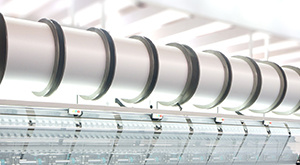08
2024
-
08
Unlocking the Secrets of Loom Beam Technology: A Comprehensive Guide to Modern Textile Manufacturing
Author:
Unlocking the Secrets of Loom Beam Technology
Loom beam technology plays a pivotal role in the textile manufacturing sector, acting as a crucial component in the weaving process. The **loom beam** is where warp yarns are stored and organized before they are woven into fabric. Understanding this technology is essential for professionals in the industry, as it influences the quality, efficiency, and cost-effectiveness of textile production. In this comprehensive guide, we will delve deeply into the intricacies of loom beam technology, its applications, and its future in modern manufacturing.
Table of Contents
1. What is Loom Beam Technology?
2. Key Components of Loom Beam Systems
3. The Role of Loom Beams in Textile Manufacturing
4. Advantages of Modern Loom Beam Technology
5. Types of Loom Beams and Their Applications
6. Innovations in Loom Beam Technology
7. Maintenance and Care for Loom Beams
8. The Future of Loom Beam Technology
9. Frequently Asked Questions
10. Conclusion
What is Loom Beam Technology?
Loom beam technology refers to the systems and mechanisms that manage the warp yarns used in weaving textiles. These beams are cylindrical in shape and designed to hold multiple layers of yarn, allowing for efficient and organized weaving processes. The warp yarns are fed from the loom beams into the weaving machine, where they interlace with the weft yarns to create fabric.
Understanding loom beam technology involves recognizing its role in supporting the weaving process. Each beam is specifically engineered to accommodate various types of yarn and fabric requirements, making it a versatile tool in textile manufacturing.
Key Components of Loom Beam Systems
To fully grasp loom beam technology, one must understand its core components:
Beam Structure
The structure of a loom beam is designed for durability and efficiency. Typically made from materials such as aluminum or composite materials, the beam's design minimizes weight while maximizing strength.
Warp Yarn Storage
The storage capacity of loom beams is critical, as it affects the production cycle. Modern loom beams can hold a significant amount of warp yarn, allowing for longer runs without the need for frequent changes.
Beam Rotation Mechanism
A reliable rotation mechanism is essential for smooth yarn unwinding. This mechanism ensures that the yarn is evenly fed into the loom, preventing issues such as tangling or uneven tension.
The Role of Loom Beams in Textile Manufacturing
Loom beams are integral to the textile manufacturing process for several reasons:
Efficiency in Production
By storing and managing multiple layers of warp yarn, loom beams facilitate continuous production runs. This efficiency reduces downtime and increases output, which is essential in a competitive market.
Quality Control
The stability and tension provided by loom beams contribute significantly to the quality of the final product. Consistent yarn tension helps ensure that the fabric produced has uniform characteristics, which is crucial for market acceptance.
Flexibility in Fabric Types
Different fabric types require different warp yarns, and loom beams can be adapted to accommodate these varying needs. This flexibility allows manufacturers to produce a diverse range of textile products efficiently.
Advantages of Modern Loom Beam Technology
Modern loom beams offer several advantages that improve the overall textile manufacturing process:
Enhanced Durability
New materials and manufacturing techniques have led to the creation of more durable loom beams. These beams can withstand the stresses of high-speed weaving, reducing the risk of breakage and downtime.
Improved Yarn Management
Advanced loom beam systems incorporate technology for better yarn management. This includes features such as automatic tension control and monitoring systems that ensure consistent performance.
Reduced Waste
With improved efficiency and precision, modern loom beams help reduce yarn waste during the weaving process, making production more sustainable and cost-effective.
Types of Loom Beams and Their Applications
Understanding the different types of loom beams and their specific applications is vital for optimizing production:
Standard Loom Beams
These are the most common type, used in a wide range of textile applications. They are versatile and can handle various yarn types.
Specialized Loom Beams
Some loom beams are designed for specific applications, such as those used in the production of heavy fabrics or technical textiles. These beams often feature reinforced structures to support heavier yarns.
Electronic Loom Beams
With the advancement of technology, electronic loom beams have been developed. These beams often include sensors and automated systems that optimize the weaving process.
Innovations in Loom Beam Technology
The textile industry is continuously evolving, and innovations in loom beam technology are at the forefront of this change:
Smart Loom Beam Technology
The integration of smart technology allows for real-time monitoring of beam performance. This technology enables manufacturers to analyze data and make adjustments for optimal efficiency.
Eco-friendly Materials
As sustainability becomes a priority, manufacturers are exploring eco-friendly materials for loom beams. This shift not only reduces environmental impact but can also lower production costs.
Automation in Loom Beam Systems
Automation is transforming the loom beam sector by reducing labor costs and enhancing precision. Automated systems can handle yarn loading and adjustments without human intervention, increasing overall efficiency.
Maintenance and Care for Loom Beams
Proper maintenance of loom beams is essential for ensuring their longevity and optimal performance:
Regular Inspections
Conducting regular inspections of loom beams will help identify wear and tear. Early detection of issues can prevent costly downtime and repairs.
Lubrication
Ensuring that the rotation mechanisms are well-lubricated will reduce friction and wear, prolonging the life of the beam.
Cleaning
Keeping the loom beam clean from dust and debris can prevent malfunctions. Regular cleaning schedules should be established as part of the maintenance routine.
The Future of Loom Beam Technology
As the textile industry continues to evolve, the future of loom beam technology looks promising:
Integration of AI
The incorporation of artificial intelligence in loom beam systems will further enhance efficiency and adaptability. AI can analyze production data to optimize settings automatically.
Sustainability Focus
With an increasing push toward sustainability, future loom beam designs will likely prioritize eco-friendly materials and processes.
Customization Options
As manufacturers seek to produce more specialized fabrics, the demand for customizable loom beams will grow. Future innovations may lead to beams that can be easily adjusted for various yarn types and production needs.
Frequently Asked Questions
What is the lifespan of a loom beam?
The lifespan of a loom beam can vary depending on usage and maintenance. Generally, a well-maintained loom beam can last several years.
Can loom beams be used for different types of fabrics?
Yes, loom beams are versatile and can be adapted for various types of fabrics, depending on the warp yarn used.
How does loom beam technology impact production costs?
Loom beam technology can significantly reduce production costs by increasing efficiency, reducing waste, and improving quality, leading to fewer defects.
What types of maintenance do loom beams require?
Loom beams require regular inspections, lubrication of moving parts, and cleaning to ensure optimal performance.
Are there eco-friendly options for loom beams?
Yes, many manufacturers are exploring eco-friendly materials and sustainable practices in the production of loom beams.
Conclusion
In conclusion, **loom beam technology** is an essential aspect of modern textile manufacturing, influencing efficiency, quality, and production costs. By understanding the components, advantages, and innovations associated with loom beams, manufacturers can harness their full potential to optimize production processes. As the industry continues to evolve, staying informed about advancements in loom beam technology will be crucial for remaining competitive in the textile market. Embracing these innovations not only enhances operational efficiency but also contributes to a more sustainable future for the textile industry.
Related news
MESSAGE
You are welcome to, we will serve you faithfully!

Follow us
Add:No. 161, Huachuan Road, Chengxi New District, Yongkang City, Zhejiang Province
Tel: 86-579-87294296 87208200(Manager Shu)
Fax: 0579-87294297

















